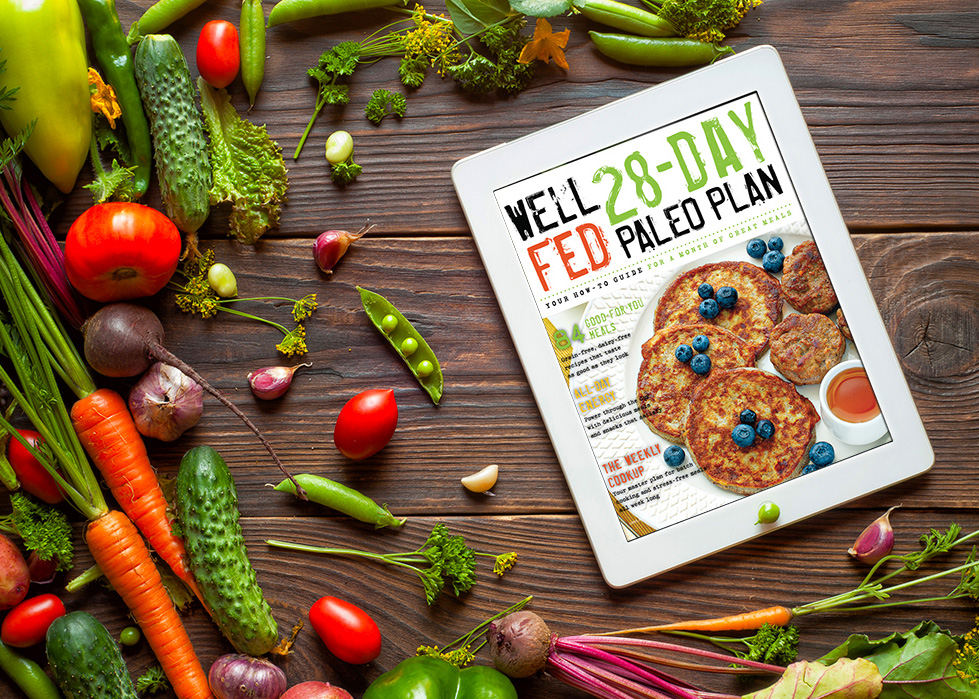As we get closer to our move — 11 days and counting! Our one-way airline tickets for Sunday, July 6 are purchased! — it's becoming...
Read More6 Easy Ways to Master Meal Planning
Like bullet journals and pretty food photos on Instagram, meal planning has become one of those things on the internet that is both inspiring and potentially intimidating. Color-coded, hand-drawn masterpieces! Spreadsheets with if-then statements! It’s enough to make a regular person want to give up.
This is my vow to you: Meal planning doesn’t have to be crazy-making.
In my first two cookbooks Well Fed and Well Fed 2, I made a pretty strong case for doing a Weekly Cookup that combines meal planning with batch cooking so your fridge is stocked with healthy food all week long. This approach works great when you have a few hours you can devote to cooking.
But what happens when you hit a busy spell and miss your Cookup?!
With my most recent cookbook Well Fed Weeknights: Complete Paleo Meals in 45 Minutes or Less, I focused on healthy, satisfying meals that could be made “to order”—no Cookup necessary. All of the recipes in Well Fed Weeknights create a full meal of protein, veggies, and fats, and most of them take just 30 minutes. Inspired by things I’ve eaten at food trucks, restaurants, family reunions, and on my travels, the recipes have bold flavors and put a lot of fun back in dinner time. The book also includes dozens of menu ideas to help with meal planning.

In this post, I’m going to outline a few ways you might tackle your own meal schedules. I’m going to start with the “meal planning” I use most often, which is less a “plan” and more a “buy a bunch of stuff I like and stock the fridge so I can grab whatever, whenever.” But I also have more concrete options that you might like, too!
1. The “No Plan” Plan
What it is: Rather than planning what to eat each day, you stock up on the basics that you know fit within your eating template. For example, stock up on lots of veggies and fruits, a variety of proteins, cooking fats like coconut and olive oil, and the extras that make meals special like nuts, dried fruit, nut butters, and fresh herbs. Instead of buying ingredients for specific recipes, you’re buying raw materials that you can turn into spontaneous meals. This is the method I usually turn to when I’m very busy because it removes the thinking involved in eating well. I know my husband and I eat about 2 1/2 pounds of protein per day, so I use that as a guide and load up on pork loin, chicken thighs and breasts, ground beef, little steaks, eggs, canned tuna and salmon, and shrimp. At meal time, I pick a protein, choose some veggies, and throw it together according to what we’re craving that day. You can read more details of this approach in my post The Method Behind My Madness—or in the Hot Plates section of Well Fed.
Why it works: It’s simple! And once you’ve determined how much you need and what your favorites are, shopping and cooking become very routine.
Potential pitfalls: The repetition can be boring, so if you or your family members require variety, this non-plan might leave you frustrated or lead to eating foods that are less-healthy out of boredom. You can combat these pitfalls by incorporating one or two more exciting recipes into your week, while you stick with the non-plan the rest of the time.
2. Theme Nights
What it is: It’s fun, is what it is. You assign a food theme to each night of the week and use that them as a guide for menu planning and shopping. For example, you could build your week around meal types like Meatball Monday, Taco Tuesday, Souper Wednesday, etc. Or pick international foods: Italian night, Chinese night, Salad night, etc. Or combine the two. You could also encourage each person in the family to select a recipe for each day of the week… whatever construct it takes to give you a template you can fill in without too much hard thinking.
Why it works: It’s FUN! (I know I said that already, but it is fun.) It eliminates some of the option paralysis you might face when there are so many decisions you need to make. If you’re responsible for feeding people who like a lot of variety or want to voice their opinions, this is an easy way to involve everyone.
Potential pitfalls: This approach has the potential to become overwhelming if you insist that each day or week needs to be unique. Food management gets a lot easier if you can allow for repetition. But something like Taco Tuesday or Chili Friday means that’s one less day you need to account for, so this construct can help you simplify if you use it as a flexible framework.
3. Full Cookup
What it is: Pick a day and cook most of the food you’ll need for the week. What you cook can be a combination of the basics I outlined in the No-Plan above, plus recipes for your favorites. For example, you might roast a chicken, grill a bunch of burgers, and then also cook a big pot of chili and a batch of salmon cakes or Scotch Eggs. That way you can alternate between simple protein+veggie meals and “fancier” dishes like chili and salmon cakes.
Why it works: It combines the best of spontaneous and planned meals, and you can cook once, then eat for days.
Potential pitfalls: It requires about 2-4 hours in the kitchen one day a week, and some busy families have a hard time finding that chunk of time. You can work around this issue by using a Mini Cookup, which I explain below, or having a big Cookup once or twice a month, when you can carve out the time, and making double batches than can be frozen for Future-You.

4. Mini Cookup
What it is: Instead of cooking all of your meals for the week, with a Mini Cookup, you can prepare the staples that make meals more fun in about an hour. Set a timer and then cook your own “packaged food:” Roast a bunch of sweet potatoes and a whole chicken or chicken parts. While that stuff is in the oven, grate a few heads of cauliflower for rice and julienne a few pounds of zucchini to make noodles. Hard-boil a dozen eggs, and make a batch of homemade mayo and a vinaigrette for salads. Then during the week, you can cook protein “to order,” add a salad, and supplement with the noodles and rice. If you’re really tight on time, you can also make a staple each day, while you’re cooking dinner. For example, while you’re making a stir-fry on the stove, you could roast sweet potatoes and chicken in the oven for the next night.
Why it works: It’s like having your own brand of convenience foods that are super healthy and minimize meal-time prep so you don’t have to plan quite so much.
Potential pitfalls: There aren’t any! Although I suppose that on some weeks, super busy people won’t even have an hour to spare.

5. Well Fed 28-Day Paleo Plan
What it is: With this meal plan, you’ll eat irresistible food every day—breakfast, lunch, dinner, and snacks. The plan includes three full weeks of recipes, shopping lists, and how-to instructions — and there’s info to teach you how to make your own meal plans using my template, so by the end, you’ll be able to continue on your own (or you can repeat the first three weeks as long as you like). My approach starts with a once-a-week cooking session: The Weekly Cookup. That prepares you for several days of eating without cooking from scratch every time — which means you can relax and spend your time doing other stuff you enjoy. Learn more about the Well Fed 28-Day Paleo Plan.
Why it works: I’ve figured out all the logistics for you, so you can just shop, cook, and eat. This plan eliminates decision fatigue, and it’s packed with delicious food that’s good for you, mind and body.
Potential pitfalls: It requires about 2-4 hours in the kitchen one day a week, plus about 30-40 minutes at dinner time, and some busy families have a hard time finding those chunks of time.
6. Real Plans: The Best Meal Planning Service
What it is: Paid services like the truly awesome Real Plans can generate a PERSONALIZED meal plan for you based on the number of people you want to feed, their food restrictions and preferences, and how many days of the week and meals per day you want to include in your plan. Real Plans also provides detailed shopping lists for the grocery store and farmer’s market, and supplies a Timeline that reminds you when you need to perform each cooking task. Real Plans includes all of my Well Fed recipes, as well as recipes from lots of other great paleo cooks, as well as the Whole30 and Stupid Easy Paleo. Learn more about the magic of Real Plans + Well Fed.
Why it works: It’s super organized and customizable, so when it’s time to plan for the week, you just type a few parameters into the tool, and it does all the work.
Potential pitfalls: It’s not free, but it is very reasonably priced. It’s well worth the small investment to free up your brain space for other tasks.
Loving Reminder: Plan a Night Off
Or as I like to call it: planned spontaneity. I heartily encourage you to plan a night off from home cooking. You can eat out, get food delivered, or keep it simple with a rotisserie chicken and bag of salad from the grocery store. This little break makes it far easier to keep your commitment to healthy eating. Enjoy it!
Loving Reminder 2: The Reckoning
No one is looking over your shoulder to judge how (or if) you do meal planning each week, and there are no Planning Police that will punish you for not creating a color-coded, every-day-accounted-for meal plan. The whole point of scheduling your food for the week is to reduce your stress and free up your brain space to think about the other awesome things in your life.
Loving Reminder 3: The Heat is On
Every Thursday, I share a post called Five Paleo Dinners To Cook Next Week—visit the archive for lots of ideas— that always includes five main dishes, a condiment, and a treat to help kickstart your meal planning for the week. Sign up for my newsletter to get a reminder in your inbox, or follow me on Twitter, Instagram, and Facebook—I always post an alert there to let you know when the list is live.
I hope you find these options helpful! If you have a meal planning tip or approach you love, share it in the comments.
In my first two cookbooks Well Fed and Well Fed 2, I made a pretty strong case for doing a Weekly Cookup that combines meal planning with batch cooking so your fridge is stocked with healthy food all week long. This approach works great when you have a few hours you can devote to cooking.
But what happens when you hit a busy spell and miss your Cookup?!
With my most recent cookbook Well Fed Weeknights: Complete Paleo Meals in 45 Minutes or Less, I focused on healthy, satisfying meals that could be made “to order”—no Cookup necessary. All of the recipes in Well Fed Weeknights create a full meal of protein, veggies, and fats, and most of them take just 30 minutes. Inspired by things I’ve eaten at food trucks, restaurants, family reunions, and on my travels, the recipes have bold flavors and put a lot of fun back in dinner time. The book also includes dozens of menu ideas to help with meal planning.

In this post, I’m going to outline a few ways you might tackle your own meal schedules. I’m going to start with the “meal planning” I use most often, which is less a “plan” and more a “buy a bunch of stuff I like and stock the fridge so I can grab whatever, whenever.” But I also have more concrete options that you might like, too!
1. The “No Plan” Plan
What it is: Rather than planning what to eat each day, you stock up on the basics that you know fit within your eating template. For example, stock up on lots of veggies and fruits, a variety of proteins, cooking fats like coconut and olive oil, and the extras that make meals special like nuts, dried fruit, nut butters, and fresh herbs. Instead of buying ingredients for specific recipes, you’re buying raw materials that you can turn into spontaneous meals. This is the method I usually turn to when I’m very busy because it removes the thinking involved in eating well. I know my husband and I eat about 2 1/2 pounds of protein per day, so I use that as a guide and load up on pork loin, chicken thighs and breasts, ground beef, little steaks, eggs, canned tuna and salmon, and shrimp. At meal time, I pick a protein, choose some veggies, and throw it together according to what we’re craving that day. You can read more details of this approach in my post The Method Behind My Madness—or in the Hot Plates section of Well Fed.
Why it works: It’s simple! And once you’ve determined how much you need and what your favorites are, shopping and cooking become very routine.
Potential pitfalls: The repetition can be boring, so if you or your family members require variety, this non-plan might leave you frustrated or lead to eating foods that are less-healthy out of boredom. You can combat these pitfalls by incorporating one or two more exciting recipes into your week, while you stick with the non-plan the rest of the time.
2. Theme Nights
What it is: It’s fun, is what it is. You assign a food theme to each night of the week and use that them as a guide for menu planning and shopping. For example, you could build your week around meal types like Meatball Monday, Taco Tuesday, Souper Wednesday, etc. Or pick international foods: Italian night, Chinese night, Salad night, etc. Or combine the two. You could also encourage each person in the family to select a recipe for each day of the week… whatever construct it takes to give you a template you can fill in without too much hard thinking.
Why it works: It’s FUN! (I know I said that already, but it is fun.) It eliminates some of the option paralysis you might face when there are so many decisions you need to make. If you’re responsible for feeding people who like a lot of variety or want to voice their opinions, this is an easy way to involve everyone.
Potential pitfalls: This approach has the potential to become overwhelming if you insist that each day or week needs to be unique. Food management gets a lot easier if you can allow for repetition. But something like Taco Tuesday or Chili Friday means that’s one less day you need to account for, so this construct can help you simplify if you use it as a flexible framework.
3. Full Cookup
What it is: Pick a day and cook most of the food you’ll need for the week. What you cook can be a combination of the basics I outlined in the No-Plan above, plus recipes for your favorites. For example, you might roast a chicken, grill a bunch of burgers, and then also cook a big pot of chili and a batch of salmon cakes or Scotch Eggs. That way you can alternate between simple protein+veggie meals and “fancier” dishes like chili and salmon cakes.
Why it works: It combines the best of spontaneous and planned meals, and you can cook once, then eat for days.
Potential pitfalls: It requires about 2-4 hours in the kitchen one day a week, and some busy families have a hard time finding that chunk of time. You can work around this issue by using a Mini Cookup, which I explain below, or having a big Cookup once or twice a month, when you can carve out the time, and making double batches than can be frozen for Future-You.

4. Mini Cookup
What it is: Instead of cooking all of your meals for the week, with a Mini Cookup, you can prepare the staples that make meals more fun in about an hour. Set a timer and then cook your own “packaged food:” Roast a bunch of sweet potatoes and a whole chicken or chicken parts. While that stuff is in the oven, grate a few heads of cauliflower for rice and julienne a few pounds of zucchini to make noodles. Hard-boil a dozen eggs, and make a batch of homemade mayo and a vinaigrette for salads. Then during the week, you can cook protein “to order,” add a salad, and supplement with the noodles and rice. If you’re really tight on time, you can also make a staple each day, while you’re cooking dinner. For example, while you’re making a stir-fry on the stove, you could roast sweet potatoes and chicken in the oven for the next night.
Why it works: It’s like having your own brand of convenience foods that are super healthy and minimize meal-time prep so you don’t have to plan quite so much.
Potential pitfalls: There aren’t any! Although I suppose that on some weeks, super busy people won’t even have an hour to spare.

5. Well Fed 28-Day Paleo Plan
What it is: With this meal plan, you’ll eat irresistible food every day—breakfast, lunch, dinner, and snacks. The plan includes three full weeks of recipes, shopping lists, and how-to instructions — and there’s info to teach you how to make your own meal plans using my template, so by the end, you’ll be able to continue on your own (or you can repeat the first three weeks as long as you like). My approach starts with a once-a-week cooking session: The Weekly Cookup. That prepares you for several days of eating without cooking from scratch every time — which means you can relax and spend your time doing other stuff you enjoy. Learn more about the Well Fed 28-Day Paleo Plan.
Why it works: I’ve figured out all the logistics for you, so you can just shop, cook, and eat. This plan eliminates decision fatigue, and it’s packed with delicious food that’s good for you, mind and body.
Potential pitfalls: It requires about 2-4 hours in the kitchen one day a week, plus about 30-40 minutes at dinner time, and some busy families have a hard time finding those chunks of time.
6. Real Plans: The Best Meal Planning Service
What it is: Paid services like the truly awesome Real Plans can generate a PERSONALIZED meal plan for you based on the number of people you want to feed, their food restrictions and preferences, and how many days of the week and meals per day you want to include in your plan. Real Plans also provides detailed shopping lists for the grocery store and farmer’s market, and supplies a Timeline that reminds you when you need to perform each cooking task. Real Plans includes all of my Well Fed recipes, as well as recipes from lots of other great paleo cooks, as well as the Whole30 and Stupid Easy Paleo. Learn more about the magic of Real Plans + Well Fed.
Why it works: It’s super organized and customizable, so when it’s time to plan for the week, you just type a few parameters into the tool, and it does all the work.
Potential pitfalls: It’s not free, but it is very reasonably priced. It’s well worth the small investment to free up your brain space for other tasks.
Loving Reminder: Plan a Night Off
Or as I like to call it: planned spontaneity. I heartily encourage you to plan a night off from home cooking. You can eat out, get food delivered, or keep it simple with a rotisserie chicken and bag of salad from the grocery store. This little break makes it far easier to keep your commitment to healthy eating. Enjoy it!
Loving Reminder 2: The Reckoning
No one is looking over your shoulder to judge how (or if) you do meal planning each week, and there are no Planning Police that will punish you for not creating a color-coded, every-day-accounted-for meal plan. The whole point of scheduling your food for the week is to reduce your stress and free up your brain space to think about the other awesome things in your life.
Loving Reminder 3: The Heat is On
Every Thursday, I share a post called Five Paleo Dinners To Cook Next Week—visit the archive for lots of ideas— that always includes five main dishes, a condiment, and a treat to help kickstart your meal planning for the week. Sign up for my newsletter to get a reminder in your inbox, or follow me on Twitter, Instagram, and Facebook—I always post an alert there to let you know when the list is live.
I hope you find these options helpful! If you have a meal planning tip or approach you love, share it in the comments.
More Like This...
I really don't understand meal plans. I mean, conceptually, I get it. When you're starting a new eating plan, an expert tells you exactly what...
Read More





I’ve got the book Well Fed and it’s got some really good information. My question is how long will these pre-cooked foods keep in the refrigerator? Particularly partially cooked vegetables. Thanks
I get asked this question a lot. I keep my cooked meat and veg about 5-6 days. That makes some people nervous; it is a personal choice. Here are some other articles that offer guidelines for how long to keep cooked food in the fridge:
Food Safety 101 from TheKitchn – https://www.thekitchn.com/food-safety-101-how-long-shoul-44033
Leftovers Guide from The Daily Meal – https://www.thedailymeal.com/leftover-guide-how-long-can-you-keep-it
Thanks!